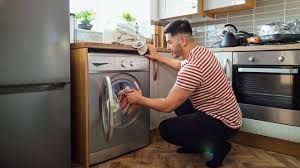Top Asked Questions About Washing Machine Repair
Q: Why is my washing machine not spinning?
A:
If your washing machine is not spinning, it could be due to several reasons such as an unbalanced load, a broken
drive belt, a faulty lid switch, or issues with the motor. Start by redistributing the load and ensuring the machine is level. If the problem persists, check the drive belt for wear and tear, and inspect the lid switch for continuity. If these components are functioning correctly, the issue might lie with the motor or the motor control board, which may require professional repair.
Q: How do I fix a washing machine that won’t drain?
A:
A washing machine that won’t drain can be caused by a clogged drain hose, a malfunctioning pump, or a blocked filter. Begin by checking the drain hose for any kinks or blockages and clear any debris. Next, inspect the pump to ensure it's working correctly; you may need to remove and clean it. Additionally, clean the filter, which is often located at the bottom front of the machine. If the machine still doesn’t drain, the issue might be with the pump motor or the control board, which may need professional attention.
Q: Why is my washing machine making loud noises?
A:
Loud noises in a washing machine can be due to various issues such as loose drum bearings, worn-out drive belts, or objects stuck in the drum. Check for any foreign objects like coins or buttons that might be causing the noise. Inspect the drive belt for signs of wear and tear and replace it if necessary. If the noise persists, the drum bearings might be worn out, which is a more complex repair that typically requires a professional technician to replace.
Q: How do I fix a washing machine that is leaking water?
A:
Water leaks in a washing machine can be caused by damaged hoses, a faulty water inlet valve, or a worn-out door seal. Start by inspecting the hoses for any cracks or loose connections and replace them if needed. Check the water inlet valve to ensure it's not leaking and replace it if faulty. Additionally, examine the door seal for any signs of wear or damage and replace it if necessary. If the leak persists, it could be due to issues with the tub or the internal components, which may require professional repair.
Q: Why is my washing machine not filling with water?
A:
If your washing machine is not filling with water, it could be due to a clogged water inlet valve, a faulty water level switch, or issues with the water supply. Ensure the water supply is turned on and that there are no kinks in the supply hoses. Check the water inlet valve for blockages and clean or replace it if necessary. If the valve is working correctly, test the water level switch with a multimeter to ensure it's functioning properly. If these components are in good condition, the problem might lie with the control board, which may need professional diagnosis and repair.
Q: How do I reset my washing machine?
A:
To reset your washing machine, first, unplug the machine from the power source and wait for about one minute. Plug it back in and open and close the door six times within 12 seconds. This process can reset the electronic controls in many modern washing machines. If this doesn’t work, consult your user manual for specific reset instructions related to your model. Resetting can help clear minor electronic glitches and restore the machine to its normal operating condition.
Q: Why is my washing machine vibrating excessively?
A:
Excessive vibration in a
washing machine can be caused by an unbalanced load, uneven flooring, or worn-out shock absorbers. Ensure that the machine is level by adjusting the feet. Redistribute the load inside the drum to balance the weight evenly. If the vibration persists, inspect the shock absorbers, which help dampen the drum's movement, and replace them if they are worn out. Excessive vibration can also damage other components, so it's essential to address this issue promptly.
Q: How do I clean the filter in my washing machine?
A:
To clean the filter in your washing machine, first, locate the filter, which is typically at the bottom front of the machine behind a small access panel. Place a towel and a shallow pan under the filter to catch any water that may spill out. Unscrew or pull out the filter and remove any debris, lint, or objects trapped inside. Rinse the filter under running water to clean it thoroughly. Reinsert the filter and secure the access panel before using the machine again. Regular cleaning of the filter helps maintain the machine's efficiency and prevents drainage issues.
Q: Why does my washing machine smell bad?
A:
A bad smell in your washing machine is often caused by mold, mildew, or trapped dirt and detergent residue. Run an empty hot water cycle with a cup of white vinegar or a washing machine cleaner to eliminate odors. After the cycle, wipe down the drum, door seal, and detergent drawer with a solution of water and vinegar. Leave the door and detergent drawer open after each use to allow air circulation and prevent mold growth. Regular cleaning and
maintenance can help keep your washing machine smelling fresh.
Q: How do I replace the drum bearings in my washing machine?
A: Replacing drum bearings in a washing machine is a complex repair that involves disassembling the machine, removing the drum, and extracting the old bearings. First, disconnect the machine from the power and water supply. Remove the top and back panels to access the drum. Carefully remove the drum and use a bearing puller to extract the old bearings. Insert the new bearings, ensuring they are seated correctly, and reassemble the machine. This repair requires specialized tools and mechanical knowledge, so if you're not comfortable performing it, consider hiring a professional technician.




